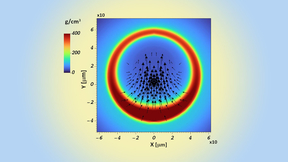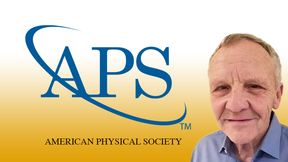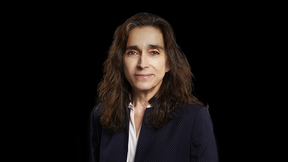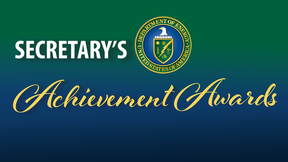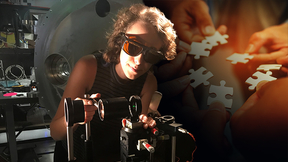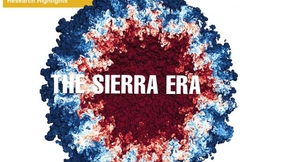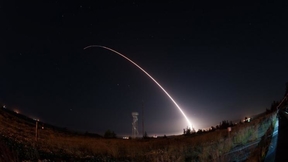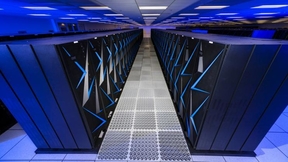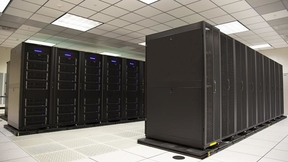Back
Strategic Deterrence
Study reveals cause of 3D asymmetry in ICF implosions
Inertial confinement fusion (ICF) implosions require very high levels of symmetry in order to reach the high densities and temperatures required for fusion induced self-heating. Even percent-level deviations from perfect spherical symmetry can lead to significant distortions of the implosion and ultimately degrade fusion performance. To that end, researchers from Lawrence…
Tarver honored with American Physical Society award
Craig Tarver, a Lawrence Livermore National Laboratory (LLNL) retiree and consultant to the Lab’s Energetic Materials Center, has been honored with the American Physical Society’s (APS) 2021 George E. Duvall Shock Compression Science Award for “theoretical advancement of the understanding of shock-driven reactions and detonation in condensed phase explosives.” Since 1987,…
LLNL Weapon Engineers, Biologists Deliver Critical Samples to Identify Skin Proteins Left on IEDs
Following a terrorist bombing, can the bomb maker be identified by skin proteins left on the bomb components they handled? To address this question, Lawrence Livermore National Laboratory (LLNL) personnel from Weapons Complex Integration (WCI) and Global Security (GS) Forensic Science and Biosecurity Centers (FSC/BSC) subjected notional bomb components handled by LLNL…
LLNL weapon engineers, biologists deliver critical samples to identify skin proteins left on IEDs
Following a terrorist bombing, can the bomb maker be identified by skin proteins left on the bomb components they handled? To address this question, Lawrence Livermore National Laboratory (LLNL) personnel from Weapons Complex Integration (WCI) and Global Security (GS) Forensic Science and Biosecurity Centers (FSC/BSC) subjected notional bomb components handled by LLNL…
Kim Budil selected as director of Lawrence Livermore
Kim Budil has been named director of Lawrence Livermore National Laboratory (LLNL). Charlene Zettel, chair of Lawrence Livermore National Security, LLC (LLNS), which manages the Laboratory for the Department of Energy's (DOE) National Nuclear Security Administration (NNSA), made the announcement to Laboratory employees Jan. 28. Budil will begin her new role on March 2…
Lab teams earn DOE Secretary Achievement Awards
Lawrence Livermore National Laboratory (LLNL) employees, participating in 10 project teams, recently earned Department of Energy (DOE) Secretary Achievement Awards. Representing some of the highest internal, non-monetary recognition that DOE employees and contractors can receive, these awards recognize DOE employees and contractors for their service and contributions to…
Lab's ACT-UP awards focus on collaborative research
With a focus on increasing joint research efforts between Lawrence Livermore National Laboratory (LLNL) and universities, the Lab’s Weapon Physics and Design (WPD) Academic Collaboration Team (ACT) University Program has awarded this year’s ACT-UP awards. Now in its second year, the ACT-UP awards were created to encourage and advance strategic partnerships among…
Lab's ACT-UP awards focus on collaborative research
With a focus on increasing joint research efforts between Lawrence Livermore National Laboratory (LLNL) and universities, the Lab’s Weapon Physics and Design (WPD) Academic Collaboration Team (ACT) University Program has awarded this year’s ACT-UP awards. Now in its second year, the ACT-UP awards were created to encourage and advance strategic partnerships among…
The Sierra Era
Lawrence Livermore’s high-performance computing (HPC) facilities house some of the fastest supercomputers in the world, including the flagship Sierra machine. Online for more than a year, Sierra primarily runs simulations for the National Nuclear Security Administration’s (NNSA’s) Advanced Simulation and Computing (ASC) Program. Sierra substantially increases the…
LLNL delivers ‘Scorpius’ pulsers amidst the pandemic
Lawrence Livermore National Laboratory (LLNL) researchers completed assembly and qualification of 16 prototype high-voltage solid state pulsed-power drivers (pulsers) in July, enabling the project to still meet the delivery schedule for the Scorpius radiography project, despite COVID-19 workplace restrictions. Eight of those pulsers were shipped to Sandia National…
Warhead replacement program passes first key milestone
Lawrence Livermore National Laboratory (LLNL) researchers passed their first program level key milestone in the W87-1 Modification Program (W87-1 Mod) on Sept. 24, keeping the program on schedule despite work stoppages due to the COVID-19 pandemic. The W87-1 Mod will replace the W78 thermonuclear warhead with a modified design of the W87 warhead. The W78 is nearing the end…
Lab stands tall on bi-annual list of Top500 supercomputers
Lawrence Livermore National Laboratory (LLNL) can lay claim to housing four of the world’s 100 most powerful supercomputers, more than any other institution according to the TOP500 List announced Monday during the virtual Supercomputing 2020 conference (SC20). The 125-petaFLOP peak Sierra, the National Nuclear Security Administration’s flagship supercomputer, remained…
Corona supercomputer gets funding for COVID-19 work
With funding from the Coronavirus Aid, Relief and Economic Security (CARES) Act, Lawrence Livermore National Laboratory (LLNL), chipmaker AMD and information technology company Supermicro have upgraded the supercomputing cluster Corona, providing additional resources to scientists for COVID-19 drug discovery and vaccine research. The recent addition of nearly 1,000 AMD…
Work resumes in support of stockpile modernization
The effort to resume hands-on work in support of stockpile modernization programs reached a major milestone May 7 with the successful execution of a focused experiment at the High Explosives Applications Facility (HEAF) at Lawrence Livermore National Laboratory (LLNL). The experiment is the first using high explosives at the Laboratory since Alameda County issued a shelter…
Lecture explores planetary defense capabilities
WHO: Lawrence Livermore National Laboratory (LLNL) scientists Megan Bruck Syal and Mary Burkey, along with retired Los Gatos High School teacher Dan Burns, will present "Planetary Defense: Avoiding a Cosmic Catastrophe.” This is the third lecture in the 2020 Science on Saturday series that delves into the mysteries of space. WHAT: This talk will cover several scenarios…
Budil shares ‘unconventional lessons’ in new book
Kim Budil, principal associate director for Weapons and Complex Integration at Lawrence Livermore National Laboratory (LLNL), is one of 36 scientists and engineers to be featured in a new book titled, “Find Your Path: Unconventional Lessons from 36 Leading Scientists and Engineers.” The book offers personal accounts of challenges, struggles, successes, U-turns and…
Open for business: NNSA, LLNL celebrate the dedication of new Advanced Manufacturing Laboratory
Officials from the National Nuclear Security Administration (NNSA) and Lawrence Livermore National Laboratory (LLNL) gathered with elected leaders and industry professionals recently to dedicate and tour the Advanced Manufacturing Laboratory, a new collaborative hub intended to spur public-private partnerships. The $10 million, 14,000-square-foot facility, located in the…
Budil honored for her work in national security
Kim Budil, principal associate director for Weapons and Complex Integration at Lawrence Livermore National Laboratory (LLNL), has made a career of advancing national security science and strengthening the partnership between the national laboratory and the University of California (UC) system. In recognition of outstanding achievements in both academia and public service,…
DOE/NNSA, Lab announce partnership with Cray to develop NNSA's first exascale supercomputer
The Department of Energy (DOE), National Nuclear Security Administration (NNSA) and Lawrence Livermore National Laboratory (LLNL) today announced the signing of contracts with Cray Inc. to build the NNSA’s first exascale supercomputer, "El Capitan." El Capitan will have a peak performance of more than 1.5 exaflops (1.5 quintillion calculations per second) and an…
New facilities to support stockpile stewardship
Leadership from Lawrence Livermore National Laboratory (LLNL), the National Nuclear Security Administration (NNSA), Livermore Field Office (LFO) and contractor Hensel Phelps broke ground earlier this month on the Applied Materials and Engineering (AME) campus at LLNL. The groundbreaking was for the start of new building construction in the 2200 block of the Laboratory and…


